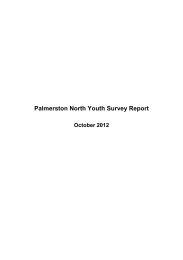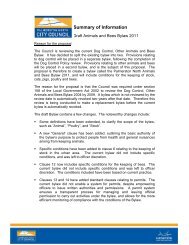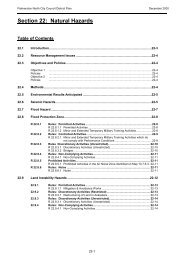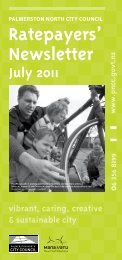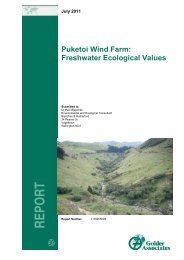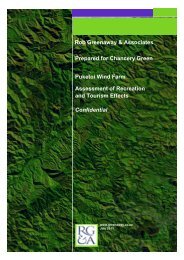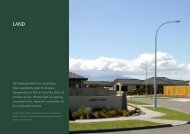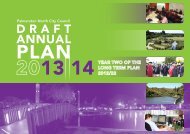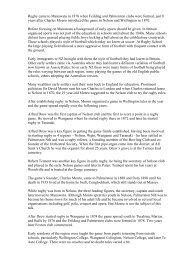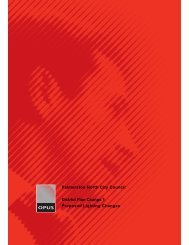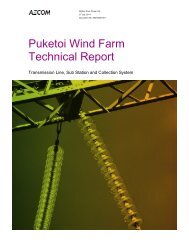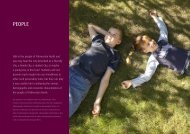2011-2012 Annual Report - Full Version - PDF - Palmerston North ...
2011-2012 Annual Report - Full Version - PDF - Palmerston North ...
2011-2012 Annual Report - Full Version - PDF - Palmerston North ...
- No tags were found...
Create successful ePaper yourself
Turn your PDF publications into a flip-book with our unique Google optimized e-Paper software.
Overview What's Happening in the City?Homelessness is not a large problem in the City - themain problem is night accommodation for singlemen, but the numbers requiring this are small.Data from MidCentral Health shows that the<strong>Palmerston</strong> <strong>North</strong> people have the best healthin MidCentral’s area. For example, <strong>Palmerston</strong><strong>North</strong> has 8% fewer than expected deaths fromall causes, including the most common causes ofcirculatory disease, cancer, respiratory disease andintentional injury and accident. These figures arein comparison with death rates across the wholeMidCentral District and are age adjusted so thedifferences are not due to different age structuresin the different areas.Life expectancy for <strong>Palmerston</strong> <strong>North</strong> people isslightly below the national average. (77.1 years forPN males compared with 78.2 nationally. 82.2 yearsfor PN females compared with 82.4 nationally.)Of course, there are clear links between healthand active lifestyles. There is a wide range ofleisure facilities and activities in <strong>Palmerston</strong><strong>North</strong> and people are generally satisfied with theopportunities they have to participate in formaland informal leisure activities.Anecdotally, at the national and local levelthere has been a drop in the number of peoplewho actively participate in formal sport andrecreation. However, this seems to reflect a movefrom organised sport to more social or informalrecreation, rather than people becoming inactive.<strong>Palmerston</strong> <strong>North</strong> has a wide range of formal andinformal education opportunities. Data showsthat many people are taking advantage of theseand <strong>Palmerston</strong> <strong>North</strong> people are well educated.• 71% of <strong>Palmerston</strong> <strong>North</strong> pre-schoolers arein early childhood education, compared with60% nationally.• About one-quarter have no formal education(similar to national levels).• About one-third have school qualifications astheir highest qualification (similar to nationallevels).• About one-quarter have post schoolcertificates or diplomas as their highestqualification (similar to national levels).• <strong>Palmerston</strong> <strong>North</strong> people are slightly morelikely than other New Zealanders to havebachelor or higher qualifications (18%compared with 16%).Environmental Trends<strong>Palmerston</strong> <strong>North</strong> is in the Lower Manawatū Riversub-catchment. The Manawatū River LeadersAccord says that “the water quality of the LowerManawatū sub-catchment is characterised by highsuspended sediment (sand, silt and mud) loads(inherited from further upstream in the catchment),and high phosphate and nitrate levels. The highnutrient levels are a combination of inputs fromthe upper part of the Manawatū catchment, as wellas non-point and point source inputs from withinthis sub-catchment. <strong>Palmerston</strong> <strong>North</strong> sewage isthe largest discharge in the Manawatū catchment.Pathogen levels are generally safe for swimming.”The City’s streets and recreational public spacesare of mixed quality. Some are well-designed andvibrant; but others are not engaging and do notprovide a people-friendly urban environment.Residential neighbourhoods show a similarpattern. Some are well connected and cohesive,but others are isolated by the way that they aredesigned, and are not good for walking around.There has been a big increase in the percentage ofresidents who are satisfied with the “look and feel”of the City. In 2007 54% said they were satisfiedwith the look and feel of the City - in <strong>2011</strong> this hadincreased to 85%. There is also plenty of greenspace in the City - the Council has 172 reservesand sportsfields, with a total area of nearly 650hectares. On top of this are walkways, streetverges, school playgrounds, etc.People made over 1.2 million journeys on theCity buses in the year to June <strong>2012</strong>. This numberhad been increasing by about 15% a year. Ofthis, 700,000 were the free trips for Massey andUCOL students and staff. However, the pictureis different for cycling. Nationally the number ofpeople cycling to work, university or school hasdropped, and particularly in <strong>Palmerston</strong> <strong>North</strong>where the decline has been three times fasterthan the national decline. There is some recentanecdotal information that the number of peoplecommuting by cycle has started to increase againin the City. There is also anecdotal informationthat the number of people cycling for recreationis increasing.16<strong>Palmerston</strong> <strong>North</strong> City Council <strong>Annual</strong> <strong>Report</strong> <strong>2011</strong>/12



